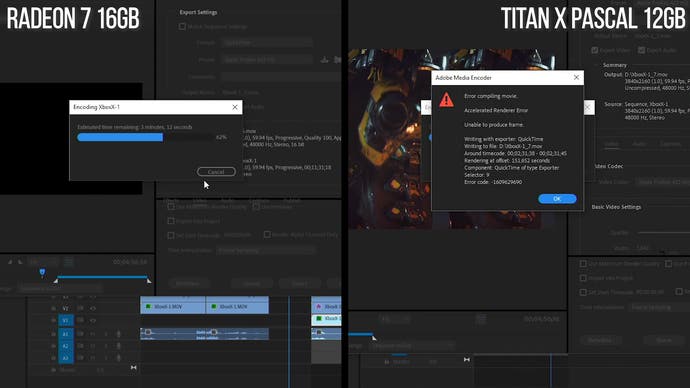AMD Radeon 7: the Digital Foundry verdict
Do you really need 16GB of GPU memory?
In the final analysis, Radeon 7 does pretty much everything AMD said that it would. The firm promised competitive performance with RTX 2080 - and by extension, GTX 1080 Ti - and that's exactly what has been delivered. What I will say, however, is that while the 4K benchmarks are pretty impressive, Radeon 7 starts to lose some of its edge when running at lower resolutions. Plotting 1080p, 1440p, and 2160p performance in titles such as Crysis 3 and Far Cry 5, it's easy to see some areas of the benchmarks where the lower resolutions run at the same frame-rates - indicating that even with an Intel Core i7 8700K running at 4.7GHz on all cores, we are hitting CPU limits. In these titles, Nvidia performance at 1080p can still be a touch wobbly, but it is still faster, suggesting that AMD's driver layer is the issue. The obvious question to ask is this: if an 8700K can hit this limit, where does this leave older i5s, i7s and Ryzen processors? I can personally recommend Radeon 7 only for 1440p or higher, whether that's standard 1440p, ultra-wide or 4K.
If the choice is between Radeon 7 and RTX 2080, it all comes down to how you would want to future-proof your set-up - with machine learning and ray tracing features, or with more memory. Both approaches have merits. There's no doubt that as AMD says, VRAM requirements for games are continually rising and in this respect, Nvidia shipping RTX 2080 with less memory than GTX 1080 Ti isn't a great move. However, what AMD doesn't say is that compute requirements rise too - and I suspect that by the time 16GB of VRAM is actually providing a game-changing experience, you'd be looking to upgrade to a faster card anyway. That leaves us with RTX 2080: it's early days with ray tracing but it's an exciting new frontier in graphics that I want to be able to appreciate. Meanwhile, DLSS 'smart upscaling' technology is highly promising - performance increases are impressive and the quality holds up. Early demos we've seen showing both technologies working in tandem are also mouthwatering: ray tracing obviously hits frame-rate, but DLSS should claw back significant levels of performance.
But what Nvidia doesn't have yet is a substantial array of titles using one or preferably both of these technologies, and because it doesn't, AMD is able to pitch Radeon 7 against a much more forward-looking architecture. Once decent support for RTX features is out there on an appreciable number of games, I do feel that the Radeon 7 vs RTX 2080 head-to-head needs to be re-run. Do technologies like DLSS hold up against standard rasterisation across a range of titles? What is the hit in terms of image quality vs the performance uplift in a challenging game like, say, Shadow of the Tomb Raider? In the here and now, we're still judging GPUs on the basis of 'how fast they go' when the innovative features Turing has delivered may well cause us to look at GPUs in a very different way.

Then there's the pricing. Nvidia's pitch with RTX was essentially that rasterisation performance stays as it is in terms of price vs performance, so essentially, the RTX features are the value added feature. I don't feel as excited about Radeon 7's alternative offering - twice the amount of memory - where the only clear benefits I could find for this were outside of gaming. I can't help but feel that an 8GB Radeon 7 that actually undercuts the RTX 2080 would have offered more value for gamers. Such a product already exists of course: a used or on-sale GTX 1080 Ti has plenty of memory and performance is competitive with the Radeon 7. In fact, it's just as much a gaming competitor to the RTX 2080 as the new AMD card if you're not interested in the Turing feature set.
Overall then, Radeon 7 is a fascinating product but not the competitive rival users really need to bring about price-cuts for high performance graphics. I'm not sure it delivers quite enough to justify its price-point but for those looking to combine both gaming with heavy content production, it does offer something different. It's also an intriguing glimpse into the capabilities of Vega - the GCN architecture seemed to have hit a wall with RX Vega 64, but Radeon 7 demonstrates that a process shrink, higher clocks and mammoth memory bandwidth can deliver some big, big performance upgrades - far higher than I expected. As a taster of the kinds of improvements to performance that the new 7nm process node and HBM2 can deliver, the potential for future graphics hardware is mouthwatering.
AMD Radeon 7 Analysis
- Introduction, Hardware Breakdown
- Assassin's Creed Odyssey/Unity, Battlefield 1, Crysis 3 - Performance Analysis Part 1
- Far Cry 5, Far Cry Primal, Ghost Recon Wildlands - Performance Analysis Part 2
- Rise of the Tomb Raider, Shadow of the Tomb Raider, The Witcher 3 - Performance Analysis Part 3
- AMD Radeon 7 - the Digital Foundry verdict [This Page]
